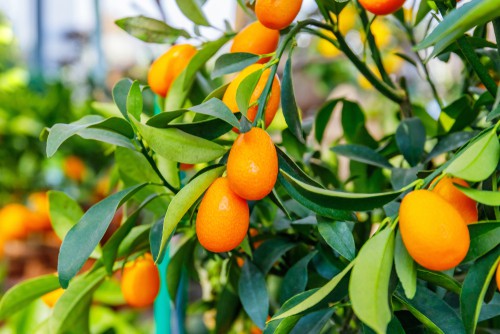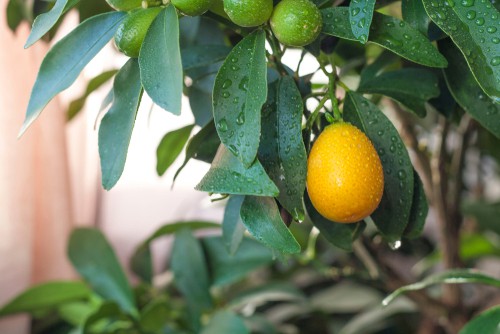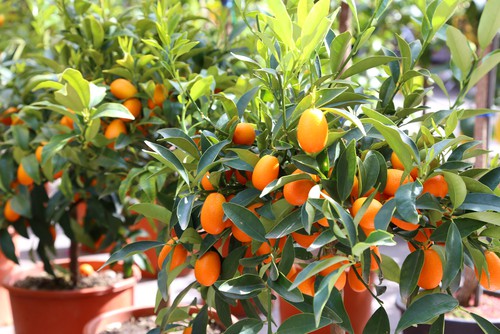Last updated on March 30th, 2022
Our site is reader supported, this means we may earn a small commission from Amazon and other affiliates when you buy through links on our site.
Kumquats are some of the most straightforward citrus trees you can grow indoors. The trees themselves are beautiful, and they boast dark green leaves with bright orange fruit. They are considered citrus fruit, and when they are ripe, you can eat the entire fruit, including the sweet, edible skin. Most people find that the skin is significantly sweeter than the sour fruit inside, which is why Kumquats are so popular when made into marmalades.
When you grow them outdoors, the trees can reach up to 3 metres tall and 2 metres wide, but when you grow them in pots (which is what most people do in the UK) you have more control over the size and can cultivate a much smaller citrus tree. So, how do you grow the Kumquat plant indoors?

Sunlight – they need at least 6 hours per day
The first consideration is the sunlight, or more importantly the amount of sun it gets. Kumquat trees require at least six hours of sun every day, so if you grow them indoors, you need to place them near a sunny window, however, make sure that said window doesn’t have too much direct sunlight because it will burn the plant’s foliage. If you don’t have access to such a window, you can always place grow lights around the Kumquat. This tree will survive best with bright, indirect sunlight so this is what we strongly recommend.
Choosing a container
When picking the container, get something that is a reasonable step up from the pot it’s already in, but be careful not to go too large. The container should be twice the size of the root ball. The material is less important. Plastic is very durable, especially for indoor use; it’s not heavy so as your plant reaches maturity it won’t add to the total weight if you need to move the plant around, for example, if you are placing it outdoors over summer. However, some people prefer wood or ceramic for decorative purposes.
Choosing the right compost
- This is a specialist blend that can be used by anybody who wants a strong and healthier plant that is provided with optimum water and nutrient availability
- The added SERAMIS granules do a fantastic job at regulating the plants water intake to ensure optimum water and nutrient availability
- This mix is loam rich to retain nutrients and for fruit development
- This 8L bag will fill a 28cm Pot
Kumquats need potting soil that is enriched. They are not particular about the pH level, however, they are particular about drainage so you might need to add gravel or a layer of pebbles to the bottom of your container, or perhaps drill some extra holes in the container depending on the type of material you are using to allow for proper drainage. You can use a specially made citrus compost or use a soil-based compost such as John Innes potting compost that will retain moisture and mix it with around 30% grit to improve drainage.
Water Kumquats

Watering is very important for a Kumquat tree. As is the case with any citrus plant, you need to make sure that the soil remains moist but never too wet. You should be able to stick your finger directly into the soil at least up to your second knuckle before you water it again. If there is dampness right at your fingertips when you start sticking your finger into the soil, you don’t need to water yet.
During the winter, when you have your plant indoors and the central heating is on, the most successful way to water is to actually mist the plant, spraying the leaves instead of watering the soil, and only watering the soil directly when it becomes dry to the touch. They usually only need watering once or twice a month in winter.
Learn more about watering and feeding citrus trees in this guide by clicking here.
Feeding Kumquats
Kumquats need food most of the year with the exception of the middle of winter. In the spring, you can give them a slow-release, multi-purpose citrus fertiliser. When they are growing, you can give them regular applications of a fish emulsion or liquid kelp fertiliser. When you give the Kumquat food, always water it well before, and after, so the fertiliser doesn’t burn the plants.
- Boosts Plant Growth & Crop Yields - Natural Seaweed fertiliser that enhances strong & healthy plant growth, promotes lush foliage, and increases crop yields for thriving plants.
- Nutrient Rich Plant Food - Enriched with iron and plant-based amino acids to nourish garden plants, improve soil health, and support plant & root development.
- Versatile & All Purpose - Ideal for lawns, fruits, vegetables, flowers, trees, and all other garden plants. Perfect for any outdoor or indoor plants.
- 100% Organic & Vegan - Seafeed Xtra is made from natural, sustainably sourced ingredients & certified Organic by OF&G.
- User Friendly Design: Comes with an easy-to-use bottle featuring a built-in measuring chamber for hassle-free application. One litre of Seafeed Xtra makes up to 500 litres of feed when diluted, suited for all size gardens.
- easy to use
- no mess
- no measuring
- lasts 15 days
- lasts up to 15days
Temperature
Kumquats are very strong and can deal with temperatures that are quite low, which is why they do well both indoors and outdoors. However, when you have them inside be sure not to put them directly next to a radiator where the temperature fluctuations are severe. Instead, you want to place it somewhere the temperatures remain somewhat steady, as you would with all citrus trees.

Repotting
Every 2 or 3 years, you might have to re-pot your Kumquat into a larger pot. This is true of all citrus plants. The best time to do this is at the beginning of spring before there are any flowers or fruit. When you re-pot, always put it in a container that’s slightly larger than the original, but not substantially.
- Citrus Focus Repotting Mix is designed for best results with the widest range of citrus trees
- It is free draining to promote healthy root growth
- Contains peat, perlite, maglime, wetting agent as well as a carefully balanced range of nutrients to support growth
- Contains a carefully balanced range of nutrients to promote healthy growth
- It is available in 2 litre bag
Pests and Diseases
Potted Kumquats have to contend with mealybug infestation as the primary pests and root rot as the primary disease. You can help prevent root rot by making sure you have well-draining soil, don’t overwater your plant, and by applying mulch around the base of the plant.
If you notice a mealybug infestation of aphids, it’s essential to tackle the issue early on by treating your tree with insecticidal soap or another commercial insecticide.
- Contact insecticide that can protect from pests for up to 2 weeks
- Kills most common insect pests on an extensive range of ornamental plants
- Protects over 30 different crops from insect attack
- Use indoors or outdoors.
Harvesting
You will know the Kumquats are ripe when the skin showcase has a deep orange shade, and the fruit is slightly soft. Most people will pull citrus fruit directly off the plant, but this can result in ripping off larger pieces of the actual plant than you intended, so you are better off using a knife or scissors to cut the fruit off.
Last update on 2025-07-06 / Affiliate links / Images from Amazon Product Advertising API







